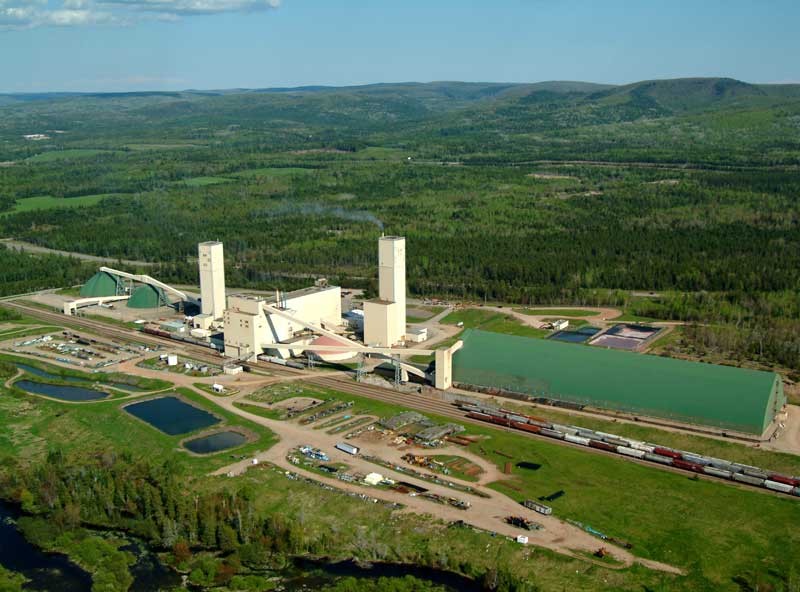Exploration & Development of N.B. Potash Resources
Penobsquis

Following the discovery of potash in the Plumweseep-Penobsquis area by the (then) New Brunswick Department of Natural Resources in 1971, exploration and development rights were granted to the Potash Company of America in 1973. Over the next decade, mine development, mill construction, and a potash shipping terminal at the Port of Saint John were completed. The first potash was produced from the mill in July, 1983. In 1993 operations were acquired by Potash Corporation of Saskatchewan Inc. and the facility was renamed PCS (New Brunswick Division) Inc. PCS (NB) Inc. has an annual production capacity of 785,000 tonnes KCl. In 2005 the company reported production of almost 750, 000 tonnes. Underground mining operations take place at depths between 400 and 700 meters. Cut and fill mining supports a unique closed loop mining and milling method, making the PCS (NB) the only potash operation in the world that returns all its wastes underground on a continuous basis. Most of the potash product is shipped by rail to the company's potash terminal at the Port of Saint John (Photo) where it is shipped to markets in Europe, Central and South America. In conjunction with its potash operations, PCS mines up to 650, 000 tonnes of de-icing and chemical salt annually. Some salt is consumed regionally; however, most is trucked to and exported from the Port of Saint John In 2002, exploratory drilling in an area southeast of the mine site resulted in the discovery of additional, potentially significant potash resources, presently undergoing detailed evaluation.
Cassidy Lake

Potash and salt were discovered in the Salt Springs area by the (then) New Brunswick Department of Natural Resources in 1973. Subsequent exploration and development rights were granted to International Minerals & Chemical Corporation (Canada) Ltd. (IMC). IMC sold the property to Denison Mines Limited in 1978. Denison proceeded with the mine and mill development phase of the project. In 1980, a 40% interest in the property was assigned to the Potash Company of Canada Limited (Potacan) and the operation became known as Denison-Potacan. Denison was to relinquish its interest in the property to its Potacan partners in 1991. The name of the facility was subsequently changed to the Potacan Mining Company (PMC). With a rated annual production capacity of 1.3 million tonnes of KCl product, PMC was New Brunswick’s largest potash operation. Disaster struck in 1996, when an unmanageable water inflow penetrated the underground workings eventually forcing permanent closure of the mining operations. In March 1998, PMC’s assets were acquired by the Potash Corporation of Saskatchewan Inc. The facility was renamed Potash Corporation of Saskatchewan Inc. (Cassidy Lake Division). Up until 2005, the mill and related infrastructure was used to upgrade standard KCl product from PCS operations in western Canada to a higher-value granular product. The division presently serves as a holding and disposal site for excess salt brine trucked daily from PCS (NB).
Millstream
The Millstream Potash Prospect is situated less than 10 kilometres west of Sussex. Detailed surface exploration and a feasibility study were carried out on the property during the 1980’s by BP Resources Canada Ltd. Eleven drill holes, detailed seismic and other geophysical studies indicate up to a 500 metre thick evaporate section comprised of several zones of sylvinite with intervening zones of carnallite and halite. The in situ, geological sylvinite resource was estimated at 256 million tonnes. A large carnallite resource, a potential source of magnesium, is also inferred. BP relinquished its interest in the Millstream prospect in 1992, returning the property to the Province of New Brunswick. In 2006, part of the property was being considered for its underground storage potential. Only half of the Millstream property has been explored. There is reasonable expectation for additional potassium and magnesium resources west of the area formerly explored by BP. The Millstream evaporite deposit may have considerable potential for multi-product recovery pending suitable extraction and processing technology.
